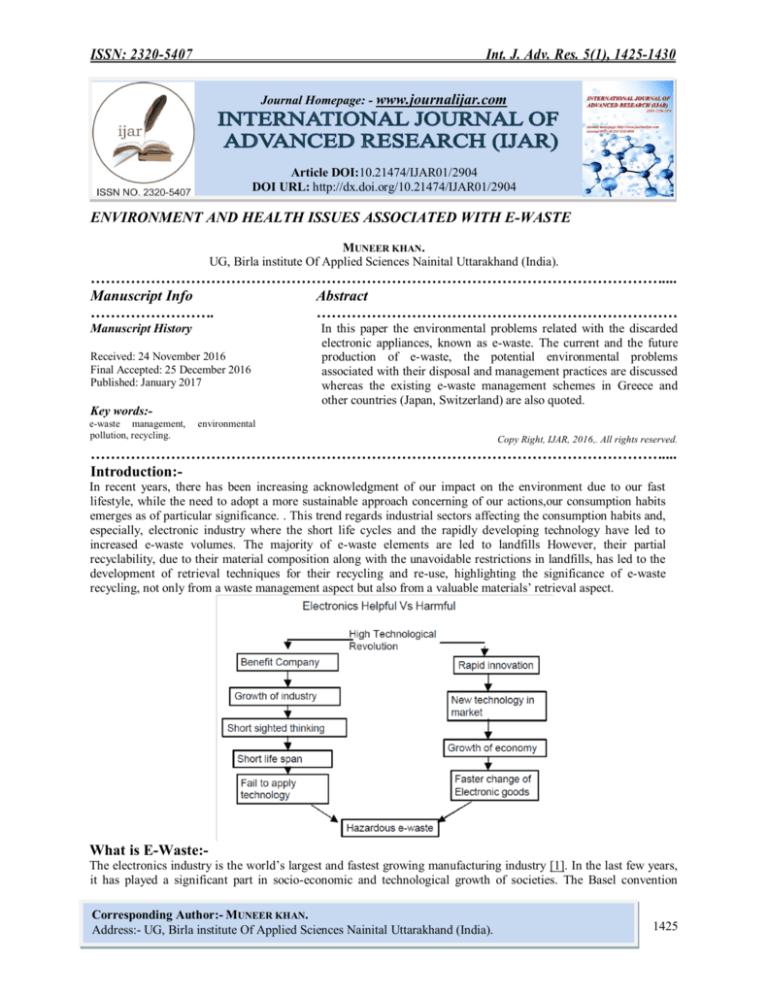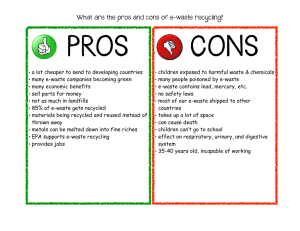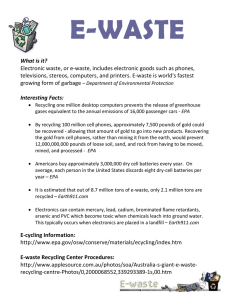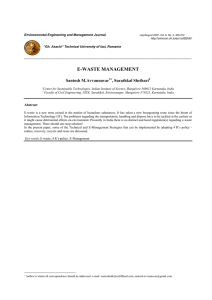
ISSN: 2320-5407
Int. J. Adv. Res. 5(1), 1425-1430
Journal Homepage: - www.journalijar.com
Article DOI:10.21474/IJAR01/2904
DOI URL: http://dx.doi.org/10.21474/IJAR01/2904
ENVIRONMENT AND HEALTH ISSUES ASSOCIATED WITH E-WASTE
MUNEER KHAN.
UG, Birla institute Of Applied Sciences Nainital Uttarakhand (India).
……………………………………………………………………………………………………....
Manuscript Info
Abstract
…………………….
………………………………………………………………
Manuscript History
Received: 24 November 2016
Final Accepted: 25 December 2016
Published: January 2017
Key words:e-waste management,
pollution, recycling.
In this paper the environmental problems related with the discarded
electronic appliances, known as e-waste. The current and the future
production of e-waste, the potential environmental problems
associated with their disposal and management practices are discussed
whereas the existing e-waste management schemes in Greece and
other countries (Japan, Switzerland) are also quoted.
environmental
Copy Right, IJAR, 2016,. All rights reserved.
……………………………………………………………………………………………………....
Introduction:In recent years, there has been increasing acknowledgment of our impact on the environment due to our fast
lifestyle, while the need to adopt a more sustainable approach concerning of our actions,our consumption habits
emerges as of particular significance. . This trend regards industrial sectors affecting the consumption habits and,
especially, electronic industry where the short life cycles and the rapidly developing technology have led to
increased e-waste volumes. The majority of e-waste elements are led to landfills However, their partial
recyclability, due to their material composition along with the unavoidable restrictions in landfills, has led to the
development of retrieval techniques for their recycling and re-use, highlighting the significance of e-waste
recycling, not only from a waste management aspect but also from a valuable materials’ retrieval aspect.
What is E-Waste:-
The electronics industry is the world’s largest and fastest growing manufacturing industry [1]. In the last few years,
it has played a significant part in socio-economic and technological growth of societies. The Basel convention
Corresponding Author:- MUNEER KHAN.
Address:- UG, Birla institute Of Applied Sciences Nainital Uttarakhand (India).
1425
ISSN: 2320-5407
Int. J. Adv. Res. 5(1), 1425-1430
defines wastes as substances or objects which are disposed of or are intended to be disposed of by the provisions of
national laws.
“Electronic waste or e-waste describes discarded electrical or electronic devices. Used electronics which are
destined for reuse, resale, salvage, recycling or disposal are also considered e-waste. Informal processing of e-waste
in developing countries can lead to adverse human health effects and environmental pollution.
Electronic scrap components, such as CPUs, contain potentially harmful components such as lead, cadmium,
beryllium, or brominated flame retardants.Recycling and disposal of e-wastemay involve significant risk to workers
and communities in developed and developing countries[2]and great care must be taken to avoid unsafe exposure in
recycling operations and leaking of materials such as heavy metals fromlandfills and incinerator ashes.[3]”
List of major Hazardous components of E-waste:E-Waste
Processed Used
Adverse Health Effects
Component
Americium
The radioactive source insmoke alarms.[5]
It is known to becarcinogenic
Adverse effects of lead exposure
include
impaired
cognitive
Lead
Solder, CRT monitor glass,lead-acid batteries, some function, behavioral disturbances,
formulations of PVC. A typical 15-inch cathode ray tube may attention deficits, hyperactivity,
contain 1.5 pounds of lead,but other CRTs have been estimated conduct problems and lower
as having up to 8 pounds of lead.
IQ. These
effects
are
most
damaging to children whose
developing nervous systems are
very susceptible to damage caused
by lead, cadmium, and mercury.
Health effects include sensory
impairment, dermatitis, memory
Mercury
Found in fluorescent tubes (numerous applications), tilt loss, and muscle weakness.
switches (mechanical doorbells,thermostats), [8] and flat screen Exposure in-utero causes fetal
monitors.
deficits in motor function, attention
and
verbal
domains.[6] Environmental effects
in animals include death, reduced
fertility, and slower growth and
development.
Found in light-sensitive resistors, corrosion-resistant alloys for The inhalation of cadmium can
marine and aviation environments, and nickel-cadmium cause severe damage to the lungs
batteries. The most common form of cadmium is found in and is also known to cause kidney
Cadmium
Nickel-cadmium rechargeable batteries. These batteries tend to damage.[7]Cadmium
is
also
contain between 6 and 18% cadmium. The sale of Nickel- associated
with
deficits
in
Cadmium batteries has been banned in the European Union cognition, learning, behavior, and
except for medical use. When not properly recycled it can leach neuromotor skills in children
into the soil, harming microorganisms and disrupting the soil
ecosystem. Exposure is caused by proximity to hazardous waste
sites and factories and workers in the metal refining industry.
A
known
carcinogen
after
occupational inhalation exposure.[6]
There is also evidence of cytotoxic
and genotoxic effects of some
Hexavalent
Used in metal coatings to protect from corrosion.
chemicals, which have been shown
chromium
to inhibit cell proliferation, cause
cell membrane lesion, cause DNA
single-strand breaks, and elevate
Reactive Oxygen Species (ROS)
levels.
1426
ISSN: 2320-5407
Int. J. Adv. Res. 5(1), 1425-1430
Sulphur
Found in lead-acid batteries.
Brominated
Flame
Retardants
(BFRs)
Beryllium
oxide
Used as flame retardants in plastics in most electronics.
Includes PBBs, PBDE, DecaBDE,OctaBDE, PentaBDE.
Filler in some thermal interface materials such as thermal
grease used
on heatsinks for CPUs and
power
transistors,[11] magnetrons, X-ray-transparent ceramic windows,
heat transfer fins in vacuum tubes, and gas lasers.
Generally non-hazardous:E-Waste Component
Copper
Zink
Aluminium
Germanium
Gold
Tin
Health effects include liver
damage, kidney damage, heart
damage, eye and throat irritation.
When
released
into
the
environment,
it
can
create sulphuricacidthrough sulphur
dioxide.
Health effects include impaired
development of the nervous
system, thyroid problems, liver
problems.[9] Environmental effects:
similar effects as in animals as
humans. PBBs were banned from
1973 to 1977 on. PCBs were
banned during the 1980s.
Occupational exposures associated
with lung cancer, other common
adverse health effects are beryllium
sensitization, chronic beryllium
disease, and acute beryllium
disease.[10]
Process Used
copper wire, printed circuit board tracks, component leads.
plating for steel parts.
nearly all electronic goods using more than a few watts of power
(heatsinks), electrolytic capacitors.
1950s–1960s transistorized electronics (bipolar junction transistors).
connector plating, primarily in computer equipment.
solder, coatings on component leads.
The environmental impact of the processing of different electronic waste components [11]:E-Waste Component
Process Used
Potential Environmental Hazard
Cathode ray tubes (used in TVs, Breaking and removal of yoke, then Lead, barium and other heavy metals
computer monitors, ATM, video dumping
leaching into the ground water and
cameras, and more)
release of toxic phosphor
Printed circuit board (image behind De-soldering and removal of computer Air emissions and discharge into
table – a thin plate on which chips and chips; open burning and acid baths to rivers of glass dust, tin, lead,
other electronic components are remove metals after chips are brominated
dioxin,
beryllium
placed)
removed.
cadmium, and mercury
Chips and other gold plated Chemical stripping using nitric and PAHs, heavy metals, brominated
components
hydrochloric acid and burning of chips flame retardants discharged directly
into rivers acidifying fish and flora.
Tin and lead contamination of surface
and groundwater. Air emissions of
brominated dioxins, heavy metals, and
PAHs
Plastics from printers, keyboards, Shredding and low temp melting to be Emissions of brominated dioxins,
monitors, etc.
reused
heavy metals and hydrocarbons
1427
ISSN: 2320-5407
Int. J. Adv. Res. 5(1), 1425-1430
Process of E-waste:-
Source: E-waste Inventory Project in Malaysia Report,2009
E-waste Global scenario:As far as global e-waste management is concerned, Switzerland is the first country to implement the organized ewaste management system in the world. Extended Producer Responsibility (EPR) and Advance Recycling Fee
(ARF) are the backbone of e-waste management system in Switzerland and other developed countries Advanced
countries like USA, UK, France & Germany generate 1.5 to 3 million tons of e-Waste annually and are among the
largest generators of e-Waste. But these countries also have standardized e-waste management processes in place.
Proper e-Waste management, from efficient sourcing and collection right upto extraction and disposal of material,
has ensured that this huge pile of junk turns into a lucrative business opportunity
E-Waste Scenario in India:Increased usage of gadgets, telecom, information and technology and appliances is collectively creating nearly 13
lakh tons of e-Waste annually in India according to an August 2014 report by the industrial body ASSOCHAM. The
report also highlighted that Delhi-NCR, Mumbai and the IT capital of India, Bengaluru collectively produce over 2
lakh tons of e-Waste per year. Another January 2015 report from Markets and Research has forecast that the Indian
e-Waste market will grow at 26.22% CAGR during 2014-2019. However, with so much electronic waste being
generated in the country, a major portion is handled by the informal or unorganized sector using improper processes,
which leads to environmental pollution and health hazards.
Unorganized e-Waste Processing in India – An Environmental Hazard[12]:Majority of the e-waste comprises computers, while telecom, electrical gadgets and health equipment account for the
remainder. Apart from various toxic substances like lead, mercury and arsenic, electronic waste also contains
valuable substances like gold, silver and rare earth elements. When it comes to managing e-waste, India is relying
heavily on the unorganized sector which accounts for over 90 per cent of the entire e-waste recycling industry.
Unorganized setups generally employ low paid workers, including over 4.5 lakh children (ASSOCHAM report),
who are not trained properly to process e-waste. Working conditions in these informal e-scrap processing setups are
1428
ISSN: 2320-5407
Int. J. Adv. Res. 5(1), 1425-1430
gravely hazardous. Dismantling or recycling of e-waste in the informal sector using crude and primitive methods
with bare hands and no facemasks, like acid stripping and open air incineration releases numerous lethal components
like polyvinyl chloride, chlorofluorocarbons, arsenic, nickel and barium, among others, into the environment causing
medical
conditions
like
cancer,
asthma,
bone
diseases
and
brain
diseases.
Majority of the global waste is produced by the developed nations. Recycling of e-Waste in western countries is
exponentially high as compared to developing nations like India which have abundant space to absorb any kind of
waste. It is ten times cheaper to ship electronic waste to Asia than recycling for USA. United States of America
(42%) tops the list of nations from which India imports e-Waste followed by China (30%) and European Union
(18%) as reported in the ASSOCHAM paper. Import of e-waste for recycling is prohibited in India – however,
according to a MAIT-GTZ survey 50,000 tons of electronic scrap is imported annually through miss declaration by
companies making India one of the biggest yards of e-waste.
Need for the Guidelines for Environmentally Sound Management:Environmentally sound recycling/re-processing[14] of e-waste starts with decontamination/ dismantling where the
concentration of hazardous material/chemical is reduced followed by recycling and recovery of the material of
economic value and then disposal of the residue in TSDF (Treatment, storage & Disposal facility). The second
category equipment like refrigerators, air conditioners and washing machines primarily contain steel plastics and
copper wiring. It also contains potentially harmful substance such as CFCs/HCFCs gases which have high ozone
depletion potential. The compressor oils are hazardous waste that need proper disposal at TSDFs or can be processed
in cement kilns. Environmentally sound recycling is required to ensure safe collection and disposal of these
substances.
MoEF/CPCB after consulting various stake holders felt the need for preparing a guidance document for
implementation of the provisions of the E-Waste (Management & Handling) Rules, 2011 that may help the
Producers, Consumer & Bulk Consumer, Collection Center, Dismantler, Recycler and Regulatory agencies
(SPCBs/PCCs) for effective compliance/implementation of these rules. This document also provides guidance on
setting up collection mechanism, dismantling and recycling operations. As the E-waste Rules place main
responsibility of e-waste management on the producers of the electrical and electronic equipment by introducing the
concept of “extended producer responsibility”(EPR). The scope of implementing such EPRs is also discussed in
these guidelines.
The collection centre has to comply with following legal requirements: To obtain an authorization from the concerned SPCBs/PCCs
To ensure that the e-waste collected by them is sent to registered dismantlers or recyclers in a secured manner.
To maintain records of the e-waste handled in Form 1
To file annual returns in Form 2
To make the records available for scrutiny by the SPCBs/PCCs
Conclusion:Despite the various new technologies that are emerging for e-waste disposal, landfilling still remains the most
common pracice in the society. The establishment and closure of landfills could pose a potential hazard to ground
water, due to leachate seepage, and air quality due to gases released. Unless proper maintenance and management is
sustained for a fairly long time (30 years), public health may be compromised as a result. Such management is costly
and potentially dangerous if faulty. Thus, a safer and more sustainable approach may be used for minimizing the
number of landfills constructed and insuring their longevity so as not to continue taking viable land for waste
disposal. It is therefore critical to divert waste from landfills through reduction and recycling.
1429
ISSN: 2320-5407
Int. J. Adv. Res. 5(1), 1425-1430
References:1.
2.
3.
4.
5.
6.
7.
8.
9.
10.
11.
12.
13.
Joseph. K, “Electronic Waste Management in India– Issues and Strategies”,Eleventh
Sakar, Anne.“Dad brought home lead, kids got sick”.
Sthiannopkao S, Wong MH. (2012) Handling e-waste in developed and developing countries practices, and
consequences. Sci Total Environmental initiative
Morgan, Russell (21 August 2006). "Tips and Tricks for Recycling Old Computers". SmartBiz. Retrieved 17
March 2009.
"Americium, Radioactive". TOXNET Toxicology Data Network.
Chen, A., Dietrich, K. N., Huo, X., & Ho, S.-m. (2011). Developmental Neurotoxicants in E-Waste: An
Emerging Health Concern. Environmental Health Perspectives , 119 (4), 431–438.[7]"Cadmium (Cd) –
Chemical properties, Health and Environmental effects". Lenntech.com. Retrieved 2 June 2014.
"Question 8" (PDF)
"Brominated flame retardants: Cause for concern?" (PDF). Environmental Health Perspectives. 112.
2004. PMC 1241790
https://www.osha.gov/SLTC/beryllium/healtheffects.html.
Wath, S. B., Dutt, P. S., &Chakrabarti, T. (2011). E-Waste scenario in India, its management and implications.
Environmental Monitoring and Assessment, pp. 172, 249–262.
Attero current scenario 2014.
GUIDELINES FOR ENVIRONMENTALLY SOUND MANAGEMENT OF E-WASTE (As approved vide
MoEF letter No. 23-23/2007-HSMd dt. March 12,2008
http://www.cpcb.nic.in/ImplimentationE-Waste
1430







